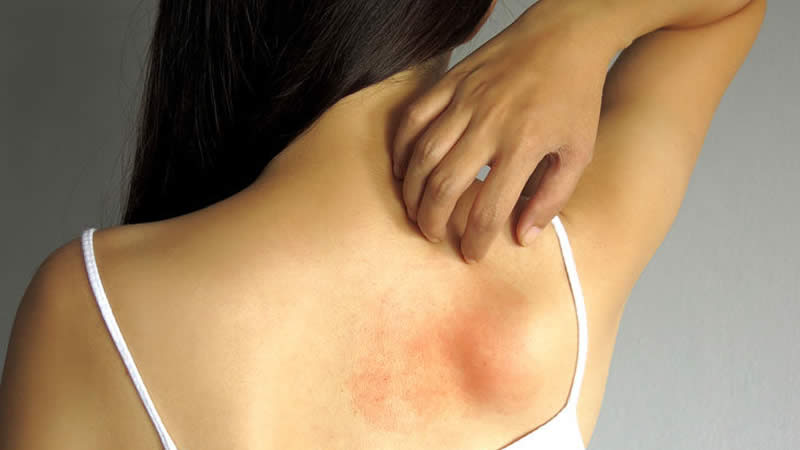Symptoms
Symptoms of the Disney rash may include:
- A rash that usually appears on both lower legs, ankles, and thighs and lasts from three to four weeks
- Single or multiple episodes of the rash
- Rash that primarily affects the skin that is exposed (sparing the skin that is covered by stockings or socks)
- Erythema (patches of flushed, red skin)
- Red patches, purple spots (called purpura), or wheals (called urticarial lesions)
- Swelling of the affected extremities
- Severe itching, burning, or pain
Causes
Disney rash commonly occurs when a person is exercising and the extremities are exposed to heat. This causes an increase in blood flow to the medium-sized or small vessels in the lower extremities.
The reason blood rushes to the small vessels is to help prevent the body from overheating. If there is a problem with return blood flow (called venous stasis), prolonged exercise in a hot or humid environment irritates the subcutaneous (under the skin) tissue on the legs and ankles.
Common Causes Related to Activity
There are several common activities known to trigger a Disney rash, these include:
- Golfing
- Running (particularly long-distance running)
- Step aerobics
- Bodybuilding
- Swimming3
- Hiking
Disney Rash and Genetics
Other factors related to the cause of the Disney rash may include hereditary factors. Some experts suggest that there may be a genetic link associated with a person’s risk of getting the Disney rash.2
Diagnosis
A diagnosis of the Disney rash is based on several factors, including a history and physical examination as well as various diagnostic tests including:
- Laboratory tests: These check for systemic (involving the entire body) vasculitis, a skin biopsy (tissue examination under a microscope) to evaluate for the presence of leukocytoclastic vasculitis (a possible indication that a person has lupus).
- Blood tests: Blood tests such as those that evaluate for a high level of C-reactive protein can confirm signs of inflammation. Blood tests can also evaluate whether you have specific antibodies—such as the ANCA test—which checks for antineutrophil cytoplasmic antibodies.
There are two primary reasons to conduct lab tests or imaging tests when a person has the Disney rash, including:2
- To evaluate the impact on other organs (in addition to the skin), which may indicate a person has systemic (involving the entire body) vasculitis.
- To rule out other causes of cutaneous (skin) vasculitis (other than the Disney rash)
Treatment
The Disney rash often subsides on its own within three to four weeks; treatment is often aimed at reducing symptoms and preventing recurrence of the rash, these modalities include:2
- Administration of nonsteroidal anti-inflammatory drugs (NSAIDs) to reduce pain and swelling
- Administration of antihistamine drugs to reduce itching
- Elevation of affected extremities
- The use of compression stockings, which relieve discomfort and promote quicker healing, while helping to prevent subsequent outbreaks
- Avoidance of vigorous exercise (temporarily, unless the rash involves recurrent episodes, in which exercise in a hot environment should be avoided)
Using Steroids for Disney Rash
Steroids—such as prednisone—should only be used for cases of severe cutaneous vasculitis with blistering and ulceration.
Prevention
Tips for preventing the Disney rash may include:
- Wearing compression stockings: Elastic socks designed to help promote good circulation in the lower extremities. A study found that symptoms of the rash were absent in areas of the legs covered with compression socks.
- Elevating the legs: This is important after long periods of walking and standing at theme parks.
- Taking frequent breaks when exercising: This is especially important in hot weather.
- Wearing cotton or other lightweight fabric that is loose to stay cool: A 2016 study discovered that wearing lightweight fabric helped prevent skin rash from occurring.
Other Rashes
There are several other rashes—that are common in the summer months that could be mistaken for the Disney rash, these include:4
Heat Rash (Prickly Heat)
Heat rash is an itchy rash that is pink or red that is likely to occur because of blocked sweat ducts.
It is often present in areas covered by clothing and often occurs when a person has applied heavy creams, is wearing thick clothing, or is in extreme environmental temperatures.5
Poison Ivy, Oak, and Sumac
Poison ivy, oak, and sumac can cause a red, swollen, itchy rash that may progress to blisters in areas of the skin that are directly exposed.
These plants all contain urushiol, which can cause an allergic reaction.
Symptoms usually present within 48 to 72 hours of exposure to the plant and could worsen in a period of up to five days after exposure. The rash usually subsides on its own in a week or two.6
Swimmer’s Itch
Because swimming has been known to be an underlying cause of the Disney rash, it’s important to note that other types of rashes commonly occur from swimming.
Swimmer’s rash, for example, is often a result of swimming in stagnant, contaminated water that may be contaminated with parasites from bird droppings. A red, itchy, patchy rash may appear within 48 hours of exposure. The rash may last for weeks but usually subsides on its own
Conclusion:
If you notice signs of a rash after visiting a theme park or after other types of exercise in a hot, humid climate, it’s important to consult with a healthcare provider, but know there is no need to panic.
You may want to take some preventative measures if a rash appears—such as putting your feet up—but be sure to talk to your doctor before taking medications or applying any type of topical cream or ointment to the rash.



